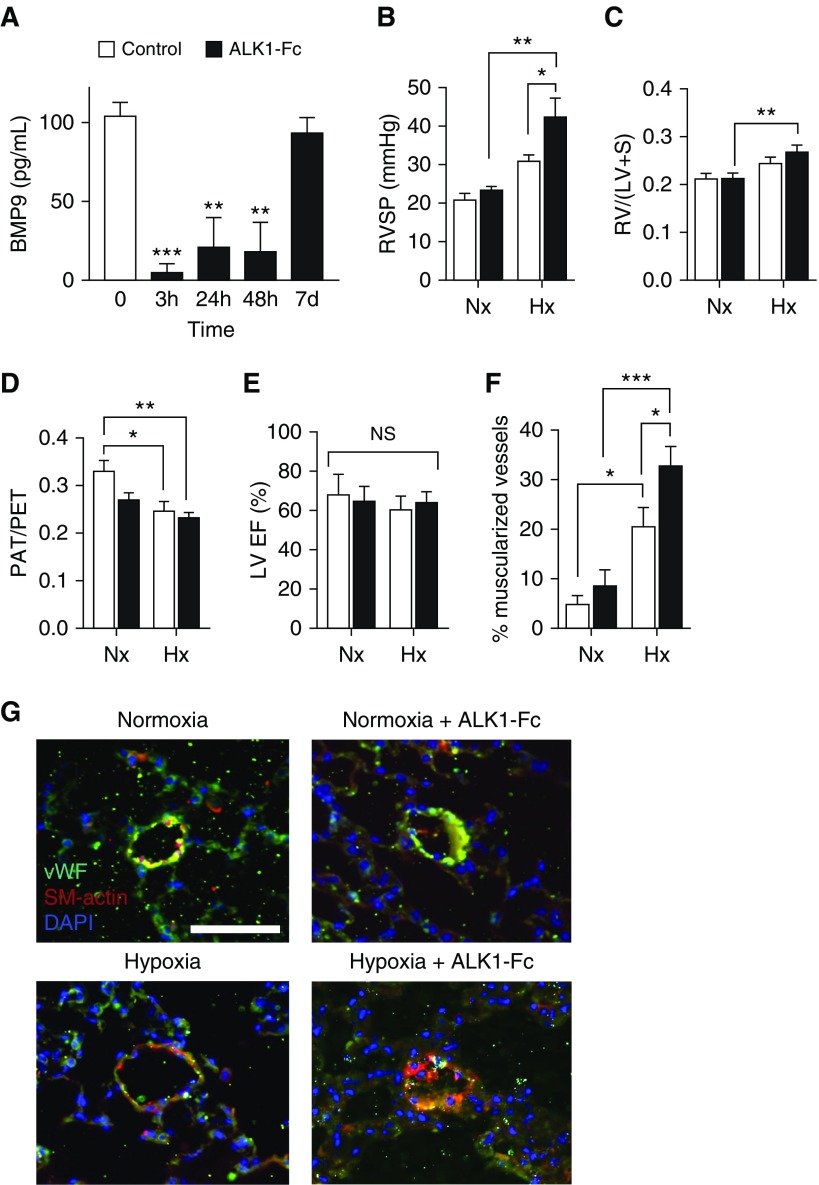Figure 5.
Administering BMP9 (bone morphogenetic protein 9) ligand trap ALK1-Fc induces severe pulmonary hypertension and pulmonary vascular remodeling in mice treated with hypoxia. (A) Administration of ALK1-Fc (5 mg/kg i.p. single injection) to adult C57BL/6 mice reduced plasma BMP9 levels at 3, 24, and 48 hours (P < 0.01; repeated measures one-way ANOVA with Dunnett multiple comparison). (B–G) Adult C57BL/6 mice received either vehicle or ALK1-Fc (5 mg/kg i.p. twice in 3 wk) under normoxic or hypoxic (FiO2, 0.10) conditions for a total of 3 weeks. (B) Exposure to hypoxia alone (n = 7) resulted in moderately increased right ventricular systolic pressure (RVSP) versus control subjects (n = 5), whereas mice receiving ALK1-Fc while exposed to hypoxia (n = 8) exhibited markedly increased RVSP as compared with hypoxia, normoxia, or ALK1-Fc mice treated under normoxia groups. (C) Exposure to hypoxia resulted in significantly increased Fulton index [RV/(LV + S)], which was not significantly increased by the addition of ALK1-Fc. (D) Treatment with ALK1-Fc under normoxic or hypoxic conditions, or exposure to hypoxia alone all decreased pulmonary artery acceleration time/pulmonary ejection time. (E) ALK1-Fc treatment does not alter cardiac function measured by left ventricular ejection fraction and fractional shortening measured by echocardiography. (F) Exposure to hypoxia increased the proportion of muscularized small arterioles (≤50 μm) based on smooth muscle α-actin (SM-actin) expression, which was further increased in mice receiving ALK1-Fc under hypoxia, shown (G) by costaining for SM-actin and von Willebrand factor (bar = 50 μm). Data are expressed as mean ± SEM. *P < 0.05, **P < 0.01, and ***P < 0.001, groups compared using two-way ANOVA with Sidak multiple comparisons tests. Hx = hypoxic; LV = left ventricle; LVEF = left ventricular ejection fraction; NS = not significant (P > 0.05); Nx = normoxic; PAT = pulmonary artery acceleration time; PET = pulmonary ejection time; RV = right ventricle; S = septum; vWF = von Willebrand factor.

